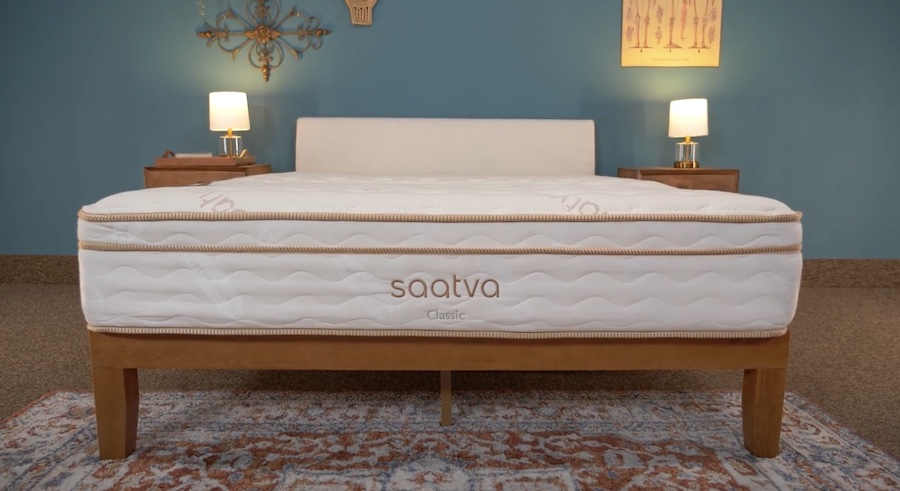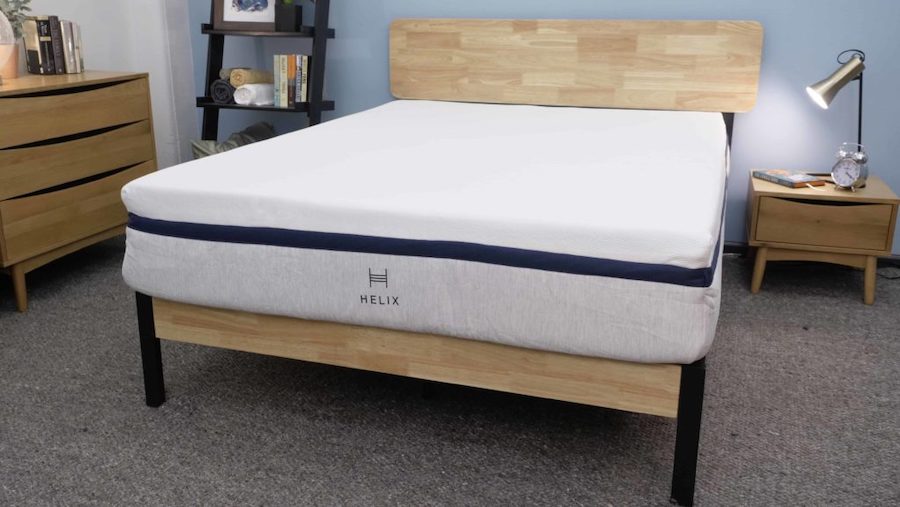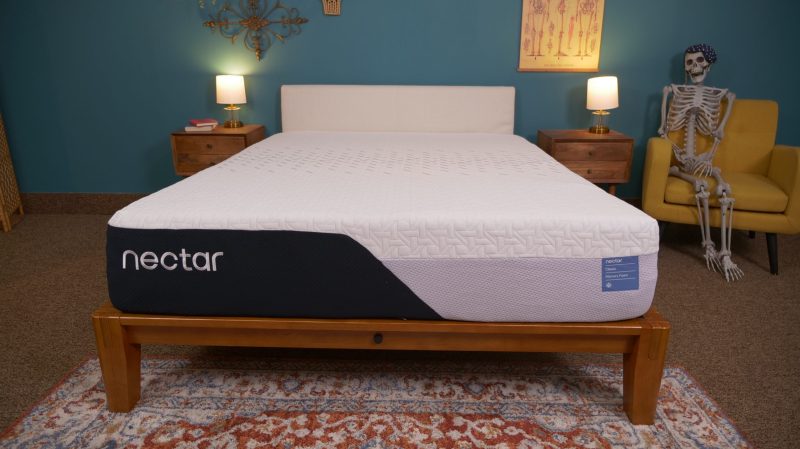Many people enjoy sitting on a cozy couch with their feet up to relax, and sleeping in a similar position could be good for our health.
Putting your feet up helps take the pressure off your veins, especially if you’ve been standing or sitting all day. Additionally, elevating your limbs is known to help blood flow, rather than forcing your circulatory system1 to work against gravity when it pushes blood up to the heart.
Before committing to an adjustable bed, consider the pros and cons of sleeping with your legs elevated; while beneficial for some, the position might not be right for everybody.
Benefits of Sleeping With Legs Elevated
Better Circulation
Raising your legs helps blood to circulate more efficiently2 and relieves pressure off your lower extremities. This is because the heart pumps blood into the arteries, but veins (like the veins in your legs) must work against gravity to return blood to the heart. Elevating your legs at heart level or slightly above reduces some of the work the muscular pumps in the lower limbs must do to return the blood to the heart and helps blood circulate more easily.2
Reduces Swelling
If you ever experience swelling in your legs, this might be due to weak circulation. What’s happening is blood and other fluids are pooling in your legs. When you elevate them, though, these fluids can more easily circulate away from the legs and reduce swelling3.
What Conditions Can Sleeping with Your Legs Elevated Improve?
Vein Conditions
- Deep-vein thrombosis4 (DVT) – This is the medical term for blood clots that form in our arms or legs, and this can be a serious condition, with some cases leading to death. Pulmonary embolisms occur when a blood clot travels through the veins and becomes trapped in the lungs, which can lead to life-threatening circumstances.
- Superficial thrombophlebitis5 – This term describes inflammation of a vein just below the surface of the skin that is caused by a blood clot. This most commonly occurs after some sort of trauma to the vein, like after using an IV line. Symptoms might include pain or tenderness along the vein, and the vein may feel cord-like or hard. If this occurs in the leg(s), keeping them elevated can help reduce the risk of blood clots, and so reduce the risk of superficial thrombophlebitis.5
- Varicose veins – Older individuals often develop varicose veins. However, promoting good health through blood circulation could help you avoid this issue altogether. Sleeping with legs elevated may help improve blood flow and prevent varicose veins6.
- Chronic venous insufficiency (CVI) – Normally, valves in your leg veins keep blood flowing back up to your heart. With chronic venous insufficiency7, though, these valves are damaged, so the blood can’t make its way back up to the heart properly. Instead, it will pool in the legs, causing symptoms like swelling and possibly ulcers.
Edema Pain and Swollen Feet
Edema8 is the swelling of a body part due to built-up fluid in body tissue, which commonly affects the arms, legs, and feet. Edema can be caused by many factors, including sitting or standing in one position for too long, eating too much salty food, poor diet, and even pregnancy.
Elevating your limbs is a simple trick to help reduce swelling and relieve discomfort and pain caused by swelling or edema.
Back Pain
While it may not necessarily cause bad posture, sleeping on your back is known to put pressure on your lower back. Resting in this position while elevating your feet or knees could be a more comfortable way to sleep, as it may relieve your lower spine from uncomfortable pressure9.
If you’re living with chronic back pain, you might want to raise your legs above the level of your heart by using a considerably large pillow or knee bolster10. Play around with different products to see which works best.
Read More: Best Mattresses for Back Pain
Spine Alignment
Many individuals assume sleeping straight on our backs is suitable for spinal alignment. However, our spines are naturally curved, almost in an “S” shape, especially towards our lower backs. Resting in a flat position could put uncomfortable pressure on this natural curvature, causing discomfort and pain and subjecting our spines to unnecessary stress.
Back sleepers could help the issue by placing a pillow under their knees, which can rotate the pelvis upward and relieve the spine. Additionally, an adjustable bed could also be a great solution.
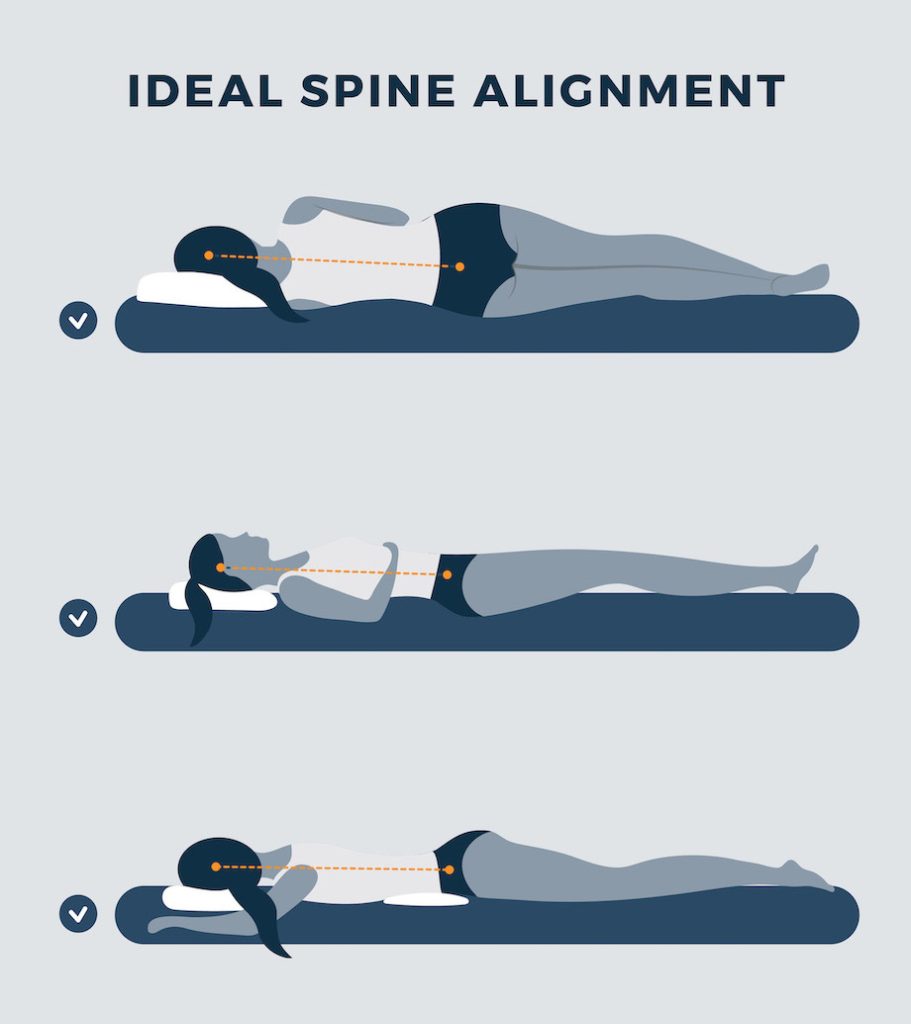
Injuries
Injuries often result in swelling, and while this isn’t necessarily concerning, it can be uncomfortable. Swollen body parts become swollen because the circulatory system sends extra fluid and white blood cells to the area to help the body heal11.
Swelling can be uncomfortable and even painful. It occurs because swollen tissues press against nerves, which send pain signals to the brain.
However, we can mitigate this pain or discomfort by elevating our legs to reduce swelling12 and promote greater blood circulation.
Strain on Heart Muscles
Our heart is a vital organ and is responsible for pumping blood through our entire body. When we’re sitting or standing, the blood in our legs has to work against gravity to travel back to our hearts.
If we elevate our legs, especially above our heart, this helps relieve this organ from the hard work it does pumping blood all day. Putting our legs up can improve blood flow and facilitate a healthy body.
Cellulitis
Cellulitis is an infection13 that develops in the deep layers of the skin after bacteria have entered through a cut, bite, or wound. Most often, this infection occurs in the lower leg(s) and symptoms can include a rash, pain in the area, swelling, or heating of the skin. In addition to taking antibiotics, medical professionals advise keeping the legs elevated to help reduce swelling.13
Post Surgery
If you have received surgery on your foot or leg, your doctor probably advised you to sleep and rest with your legs elevated. This is simply to reduce pain and swelling, and also prevent the likelihood of blood clots while you’re sedentary and recovering. Blood clots are more likely to occur14 after surgery.
Pregnancy Swelling
When you’re pregnant, the body holds more water than usual, which can result in swelling15 – particularly in the legs, ankles, and feet. Additionally, pressure in the growing womb can affect how the blood flows to the legs, further increasing fluid buildup. To reduce some of this swelling, the National Health Service recommends resting with your feet elevated as much as you can.15
Lymphedema
Normally, the body’s lymphatic system drains a fluid called lymph from throughout the body. This is important as it defends the body against infections. With lymphedema16, though, the lymphatic system is not properly draining this fluid, and swelling of the tissue occurs. This usually affects the arms and legs. Doctors recommend those with lymphedema in the legs elevate their legs17 when resting to reduce swelling and improve circulation.
Is it Bad to Sleep With Your Feet Elevated?
In short, no, it’s not wrong to sleep with your feet elevated. Granted, we’re not suggesting you sleep with your legs straight up against a wall. However, if you’re a side sleeper, snoozing with your legs raised may not be an easy position.
Additionally, sleeping with your legs elevated may not be comfortable for those with restless legs syndrome (RLS)18. Those who experience this condition have a difficult time getting quality sleep because of an almost irresistible urge to move their legs. If a prop to keep your legs elevated is added to the equation, your quest for comfort may be further hindered because you will now have to move the prop as you move your legs.
Learn More: Restless Legs Syndrome
If you are a combination sleeper, sleeping with your legs elevated via a pillow or bolster may make it more difficult for you to change positions through the night. This may entail having to reposition a pillow or bolster to keep your legs elevated as you move from one position to another, causing you to awaken more than you normally would.
It is important to note that while sleeping with your feet elevated may help alleviate some of the symptoms of a variety of medical conditions, you should always consult with your doctor about pre-existing conditions or symptoms of potential new conditions.
How to Sleep Comfortably with Elevated Feet
There are a few ways to snooze comfortably with your legs raised, and many people practice this by using a pillow or existing items they already have at home. However, if you need further assistance, there are multiple products to help.
Use an Adjustable Bed
Resting with pillows under your body may seem like a great idea at first, but we often shift and adjust during the night while we’re subconscious, so we may not realize when we’ve kicked them out from underneath us, negating the practice.
An adjustable bed could help ensure your body is positioned in an advantageous position all night long without having to worry about ruining your assistive accessories during the night. Further, as we all come in various shapes and sizes, an adjustable bed frame can help you raise your legs to just the right height for your body, allowing you to rest comfortably.
One adjustable mattress we suggest is the Saatva Solaire. Not only is this mattress compatible with adjustable bases, but users can also customize its comfort level. The Solaire is equipped with an air chamber that can be modified from 1-50 depending on how firm you want the bed to feel. We also suggest the Tempur-Pedic TEMPUR-Adapt for a high quality adjustable mattress. This bed is compatible with adjustable power bases, and shoppers can pick from two versions of this bed: a medium-firm all-foam model and a medium-firm hybrid model.
Get More Info: Best Mattress for Adjustable Beds and Best Adjustable Bed Frames
Browse some of our favorite adjustable mattresses:
Product
Type
Score
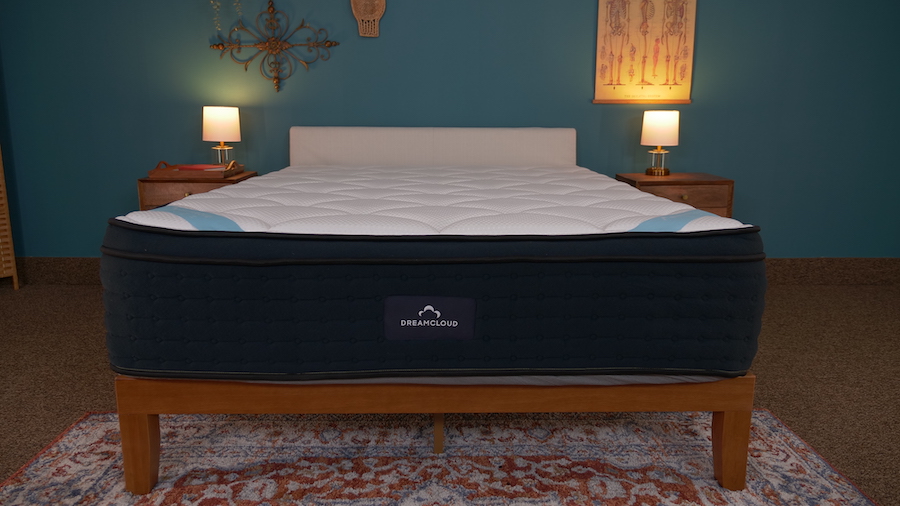
Product
Type
Score
Use Pillows
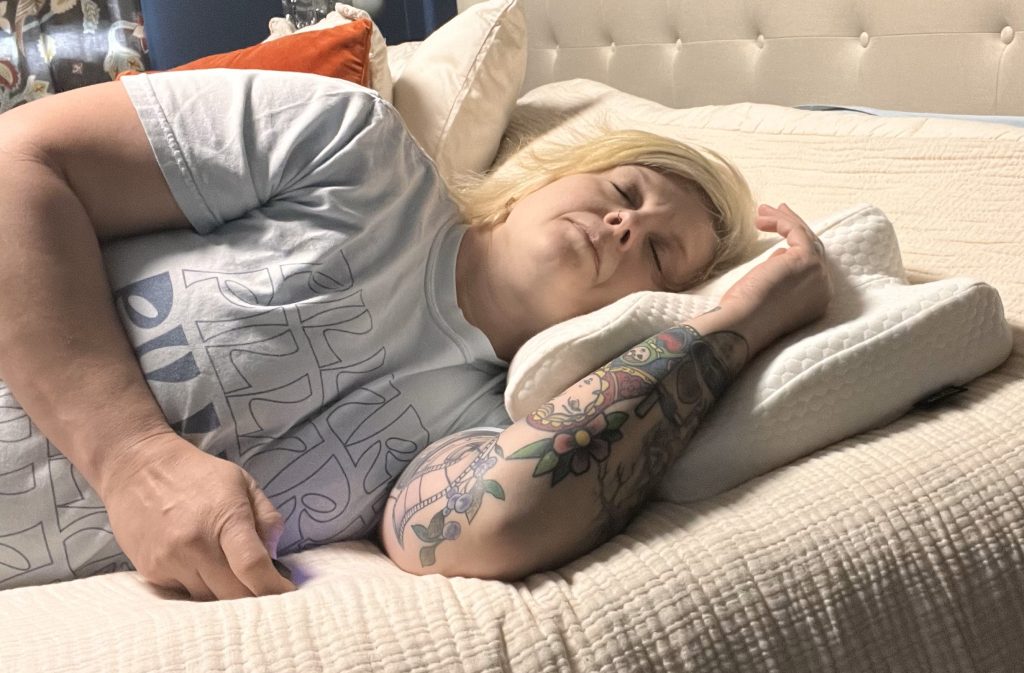
Some individuals sleep “like a log” and rarely move all night long. If you don’t shift much during the night, using pillows could be an excellent strategy to help alleviate any swelling or blood circulation issues.
Remember that one pillow likely won’t be enough to raise legs to a height that will significantly help, as you’ll probably want to raise your legs above the heart. A great solution could be a wedge pillow which will likely be more stable than a regular pillow and more comfortable for your legs with the wedge’s steady incline.
We suggest the Helix Wedge Pillow as a great wedge pillow. This pillow contains gel memory foam to contour your natural shape while keeping you cool and comfortable at the same time.
Solution for Side Sleepers
Snoozing as a side sleeper who needs the legs elevated can present an issue, as this isn’t an ideal position for raising legs. Elevating your legs too much while resting on your side could affect your spine, creating more discomfort, so it’s essential to take a gentle approach before you find a solution that works.
A way around this issue is by using folded-up blankets instead of pillows. Blankets could be folded up so that you can adjust the height to suit your needs. Additionally, a leg elevation pillow could provide an excellent solution, as they are created specifically for the purpose of raising one’s legs.
A great mattress for side sleepers would be the Helix Midnight mattress paired with the Tempur-Pedic All Purpose Pillow. The Helix Midnight features a medium-firm feel that won’t be too firm for people who sleep on their side. Another advantage is that this mattress is made with memory foam, which is excellent for reducing pressure buildup in the hips and shoulders.
Tempur-Pedic’s All Purpose Pillow can be used for great neck or lumbar support or you can place it between your legs to help you rest more comfortably on your side.
Frequently Asked Questions About Sleeping with the Legs Elevated
Is it okay to sleep with the legs elevated all night?
Although it is always advisable to check with a medical professional if you have any concerns about your health and wellness, sleeping with your legs elevated is a seemingly safe and effective way to help with a host of sleeping issues and medical conditions. Elevating your legs with a pillow or bolster can help with spinal alignment, but it can also help prevent deep vein thrombosis, promote better blood circulation, and treat edema and other swelling.2, 3, 4, 9
Is it better to sleep with the legs elevated or the head elevated?
Sleeping with your head or legs elevated can be very beneficial to your sleep schedule as well as your overall health. However, they differ in what they help. While keeping your legs elevated helps keep your spine aligned and promotes better circulation, sleeping with your head propped up helps alleviate snoring and some sleep apnea19, and acid reflux20. 2, 9
How high should you elevate your legs?
For most people, it is a good idea to keep your ankles and calves elevated slightly above your thigh to optimize the benefits that come from sleeping in that position.

Rachael Gilpin
Content Writer
About Author
Rachael is a content writer for Sleep Advisor who loves combining her enthusiasm for writing and wellness.
References:
- Patel, Shivik K., Scott M. Surowiec. “Venous Insufficiency”. National Library of Medicine. Last modified August 1, 2022.
- Ielapi, N., et. al. “Elevate to Alleviate – Evidence Based Vascular Nursing Study”. Dove Press. 2022.
- “The Yoga Pose You Need: The Health Benefits of Legs Up the Wall”. Cleveland Clinic. 2021.
- “Deep Vein Thrombosis”. University of California – Davis Health. Webpage accessed April 27, 2023.
- “Superficial thrombophlebitis”. Mount Sinai. Webpage accessed April 27, 2024.
- Antani, Meghal R.., Dattilo, Jeffrey B. “Varicose Veins”. National Library of Medicine. Last modified November 12, 2022.
- “Chronic Venous Insufficiency (CVI)”. Cleveland Clinic. Last modified July 17, 2022.
- “Edema”. Mayo Clinic. Last modified January 4, 2024.
- Cultivating Health. “8 tips to help ease your back pain”. UC Davis Health. 2022.
- “Back Care” University of Michigan. Webpage accessed April 27, 2024.
- “Swelling: The Body’s Reaction to Injury”. Nationwide Children’s. Webpage accessed April 27, 2023.
- “Swollen Feet and Ankles: Treatments to Try”. Cleveland Clinic. 2021.
- Corliss, Julie. “Cellulitis: How long does it take to heal on legs?”. Harvard Health Publishing. 2023.
- “Preventing Blood Clots”. National Heart, Lung, and Blood Institute. Last modified September 20, 2022.
- “Swollen ankles, feet and fingers in pregnancy”. National Health Service. Last modified March 10, 2021.
- “Lymphedema”. Mayo Clinic. Last modified November 24, 2022.
- “Lifestyle Changes for Lymphedema”. NYU Langone Health. Webpage accessed April 27, 2023.
- “Restless Leg Syndrome (RLS)”. Johns Hopkins Medicine. Webpage accessed April 27, 2023.
- Danoff-Burg, Sharon., et. al. “Sleeping in an Inclined Position to Reduce Snoring and Improve Sleep: In-home Product Intervention Study”. JMIR Formative Research. 2022.
- “Will a Wedge Pillow Help My Acid Reflux?”. Cleveland Clinic. 2023.

